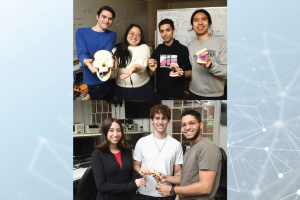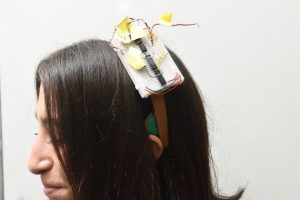
The following was originally published by the Hub.
Johns Hopkins Students Aim to Take the Bite Out of Noisy Dental Drills
Mechanical engineering majors at Johns Hopkins created a device that dampens the din of dental drills during procedures
A team of mechanical engineering students from Johns Hopkins University is working with a Florida dentist to develop a device that aims to make dental procedures less daunting for many patients.
The apparatus, which dampens the whirring and buzzing sound of the drill used during procedures such as root canals, was inspired by Tallahassee-based dentist Jordan Rigsby’s personal experience undergoing the loud procedure himself after having performed it on others many times.
“It was really jarring,” Rigsby said of the sound and vibrations that came when the drill met teeth. “Our dental drills are very quiet these days, but the conduction from the bone to the ear results in the sound being quite loud for many patients. It made me understand why patients dreaded that sound almost as much as they worried about pain during dental procedures.”
He wondered if the concept behind noise-canceling headphones could be translated to work inside the mouth to make the procedure less noisy—and thus, less frightening—for his patients.
“I was playing around with some things, and I hooked an audio wire into a dowel (a wooden peg), and when I bit down I could hear music,” he said. “I thought that if you hook it to a DC motor, it might be able to provide offsetting vibrations through the patient’s jaw which would dampen the effect from the drill.”
Rigsby contacted Johns Hopkins Engineering’s Senior Design program to ask students to refine his model and make noise cancellation a reality. The team members—mechanical engineering majors Conor Allan, Elizabeth Dolan, David Paik, and Daniel Shenkelman—did just that, using an anatomical model skull, and their own mouths, as sound conductors. The team will present its prototype at the Whiting School’s annual Design Day on May 1.
“The device picks up vibrations and produces an ‘anti-noise’ wave that is the exact opposite of the unwanted noise,” Shenkelman said. “The noise and anti-noise cancel, like adding -1 to 1, equaling zero.”
Using the student team’s device, dental patients can simply take a break from the growling and often frightening sound of the drill or use it to tune into music for an added distraction.
The team’s solution differs from that used in headphones in one crucial way: While headphones capture vibrations from the air, the dental plate dampens vibrations sourced from inside the patient’s mouth.
“This is a difficult problem to solve, and there is no commercially available solution,” said Shenkelman. “Creating a system that makes patients more comfortable is very rewarding to me and the team as engineers.”
“They made a really great prototype,” Rigsby said. “We’ve been utilizing it ever since.”
The following was originally published by the Hub.
Johns Hopkins Student Design Sparks Hope for Migraine Relief
Electrical engineering students are developing a device targeting the root cause of chronic headaches
A team of undergraduate engineers at Johns Hopkins University is working on a noninvasive, wearable, and reusable device that combats migraine headaches.
Electrical and computer engineering students Rita Rozental, Christian Kanzki, and Kyle Cooper call their device Cerebri. It works by stimulating and desensitizing the trigeminal nerve, located in the face and head and believed to play a key role in the origin of migraines. The students will display their prototype and describe their approach at the Whiting School of Engineering’s annual Design Day on May 1.
Cerebri relies on dry electrodes, which do not require direct skin contact or the use of gels or pastes, to transmit low-level electrical pulses to the trigeminal nerves. Team members say that this innovative approach circumvents the drawbacks of wet electrodes, such as skin irritation and limited usability on hairy skin or areas prone to sweat.
Putting on the device is as easy as wearing a headband, although it should be be positioned on atop the head for optimal stimulation and discreetness during daily use. This band holds the dry electrodes against the scalp, delivering electrical impulses to the trigeminal nerve.

Rita Rozental models Cerebri
“According to current research, the stimulation should be effective after 20 minutes to an hour of wear but the device could be worn for longer if needed, as it is used both to treat migraines at their onset and to prevent future migraines,” said Rozental, whose team developed the appliance for its engineering senior design project.
The team believes Cerebri’s uniqueness lies not only in its combination of existing technologies and possible patentability but also in the fact that it is wearable, cost-effective, and can easily be integrated into users’ daily lives. As the twin sister of a migraine sufferer, Rozental knows how much such a device is needed.
“Pharmaceuticals [for migraines] come with long trial periods and no guarantee of relief,” she says. “Current electrostimulation treatments, while promising, are expensive, can only be applied to hairless areas of the head, and are impractical for daily wear. We hope our device will give migraine sufferers another effective and affordable option.”
Images: Will Kirk | Johns Hopkins University